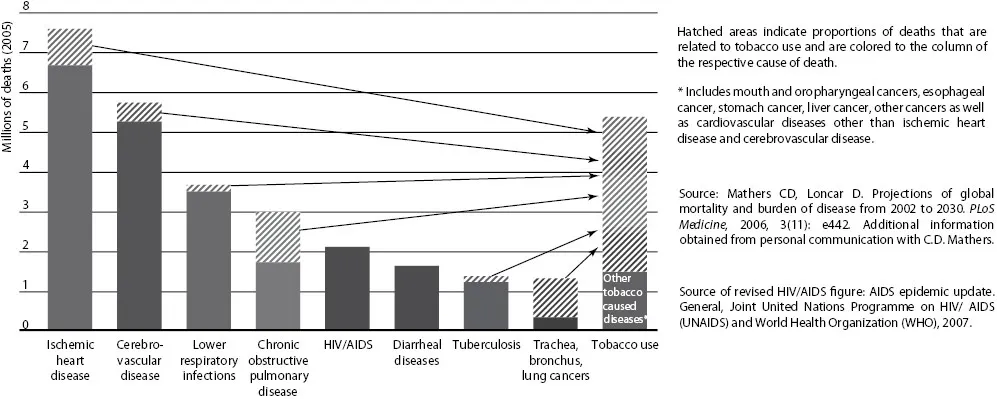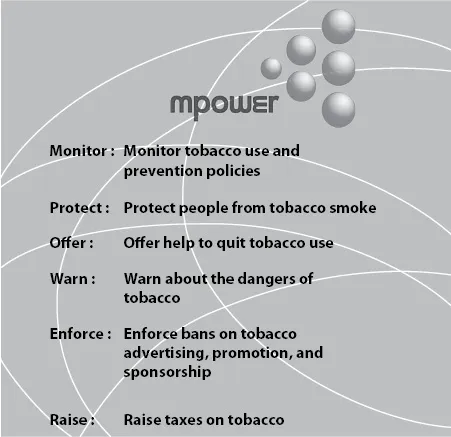
eBook - ePub
Tobacco Cessation
A Practice Manual for Primary Care Physicians
Rajmohan Panda, Manu Raj Mathur, Rajmohan Panda, Manu Raj Mathur
This is a test
Partager le livre
- 18 pages
- English
- ePUB (adapté aux mobiles)
- Disponible sur iOS et Android
eBook - ePub
Tobacco Cessation
A Practice Manual for Primary Care Physicians
Rajmohan Panda, Manu Raj Mathur, Rajmohan Panda, Manu Raj Mathur
Détails du livre
Aperçu du livre
Table des matières
Citations
À propos de ce livre
Cessation of tobacco use is the need of the hour given that it is the single largest cause of disease and premature death in the world. This book covers epidemiology and risks, user classification, nicotine replacement therapy, pharmacological aids, behavioral modification and patient counseling techniques, along with personalized action plan development.
Key Features
-
- Covers all aspect of tobacco cessation.
-
- Provides guidance on differential diagnosis and includes useful decision-making flowcharts.
-
- Provides step-by-step guidance to counsel tobacco users in routine clinical practice.
-
- Discusses the process of setting up a cessation centre.
-
- Facilitates in-depth understanding of the subject through case studies at the end of each chapter
Foire aux questions
Comment puis-je résilier mon abonnement ?
Il vous suffit de vous rendre dans la section compte dans paramètres et de cliquer sur « Résilier l’abonnement ». C’est aussi simple que cela ! Une fois que vous aurez résilié votre abonnement, il restera actif pour le reste de la période pour laquelle vous avez payé. Découvrez-en plus ici.
Puis-je / comment puis-je télécharger des livres ?
Pour le moment, tous nos livres en format ePub adaptés aux mobiles peuvent être téléchargés via l’application. La plupart de nos PDF sont également disponibles en téléchargement et les autres seront téléchargeables très prochainement. Découvrez-en plus ici.
Quelle est la différence entre les formules tarifaires ?
Les deux abonnements vous donnent un accès complet à la bibliothèque et à toutes les fonctionnalités de Perlego. Les seules différences sont les tarifs ainsi que la période d’abonnement : avec l’abonnement annuel, vous économiserez environ 30 % par rapport à 12 mois d’abonnement mensuel.
Qu’est-ce que Perlego ?
Nous sommes un service d’abonnement à des ouvrages universitaires en ligne, où vous pouvez accéder à toute une bibliothèque pour un prix inférieur à celui d’un seul livre par mois. Avec plus d’un million de livres sur plus de 1 000 sujets, nous avons ce qu’il vous faut ! Découvrez-en plus ici.
Prenez-vous en charge la synthèse vocale ?
Recherchez le symbole Écouter sur votre prochain livre pour voir si vous pouvez l’écouter. L’outil Écouter lit le texte à haute voix pour vous, en surlignant le passage qui est en cours de lecture. Vous pouvez le mettre sur pause, l’accélérer ou le ralentir. Découvrez-en plus ici.
Est-ce que Tobacco Cessation est un PDF/ePUB en ligne ?
Oui, vous pouvez accéder à Tobacco Cessation par Rajmohan Panda, Manu Raj Mathur, Rajmohan Panda, Manu Raj Mathur en format PDF et/ou ePUB ainsi qu’à d’autres livres populaires dans Medicina et Teoría, práctica y referencia médicas. Nous disposons de plus d’un million d’ouvrages à découvrir dans notre catalogue.
Informations
Chapter 1
Introduction
Manu Raj Mathur
Objectives
The major objectives are to
•Learn about the burden of different forms of tobacco use
•Understand the importance of tobacco cessation and role of physicians
Skill Sets You Will Acquire
You will be able to conceptualize
•The burden of tobacco use in India
•The importance of tobacco cessation services in India
•The role of health care professionals in tobacco cessation
Background
In India, every third adult consumes tobacco* which is an established major risk factor for noncommunicable diseases (NCDs), leading to one million smoking-related deaths per annum. The death burden is expected to rise in low- and middle-income countries, like India, due to the current pattern and alarming rise in tobacco use.1,2 There are 275 million tobacco users (111 million smokers) in India that mostly affect the vulnerable lower socioeconomic and rural populations (Figure 1.1).3

Figure 1.1 Tobacco use is a risk factor for six of the eight leading causes of death in the world. (From WHO Report on Global Tobacco Epidemic, 2008.)
Tobacco use is classified under mental and behavioral disorders in accordance with the International Classification of Diseases (ICD-10).4 Around 53% current smokers in India have either no interest in quitting or are undecided about their intention to quit. A slightly higher proportion (55%) of current tobacco users report no intention to quit. This clearly signals the need to fully utilize a range of cost-effective tobacco control approaches such as legislation, education, and cessation. A comprehensive tobacco control approach (Figure 1.2) will help reduce smoking prevalence and the associated morbidity and mortality in the long term. But, among these, tobacco cessation interventions will reap health benefits in the short term, leading to a reduction in near-term tobacco-related mortality and morbidity,5–7 whereas others would take two to three decades.

Figure 1.2 MPOWER measures introduced by WHO.
Health care professionals have a role to play in all aspects of tobacco control, but their position naturally lends itself to “W,” to warn about the dangers of tobacco, and, “O,” to offer help to quit.8
Since 2001, only 19 public tobacco cessation centers have been established in India.9,10 Their establishment within the tertiary care health facilities gave only a limited access to tobacco users, particularly to those living in rural areas. They were also poorly accessed by youth.11 These centers, therefore, could serve only 34,741 tobacco users during the first 5 years; a small fraction of tobacco users who made an attempt to quit.11 The available manpower in these centers was also inadequate to serve the population of 20–40 lakhs (2–4 million). It is critical, therefore, to address the need for socially vulnerable groups with limited access to cessation service utilization by establishing countrywide tobacco treatment facilities. In a way, India is already late in making its provision at the level of primary care, as has been recommended by the WHO, with reference to the availability of quitlines.12
According to the GATS India survey, about two out of five current tobacco users (smokers: 38%, tobacco chewers: 35%) have attempted to quit in the past 12-month period. In 2010, among smokers, 9% used counseling and another 4% used pharmacotherapy for cessation. In users of smokeless tobacco, 8% used counseling to quit and another 22% used other methods. These facts indicate an ample opportunity to explore ways to improve the demand for tobacco cessation services in India.
The GATS India survey also reports that the overall participation of health care professionals (HCPs)—to ask and assist tobacco users to quit is quite low. Of the total tobacco users visiting a health facility, only 46% smokers and 27% of smokeless tobacco users were asked by the HCPs to quit. The tobacco users who were further assisted to quit was even lower. This raises concern about the capability of HCPs to intervene with tobacco users. A system-wide approach to tobacco treatment, at various levels of health care would greatly assist HCPs. This has yet to be addressed.
Empowering doctors to provide behavioral counseling details for the skills (counseling) needed for tobacco treatment is a challenge. The behavioral change theories (e.g., plans, responses, impulses, motives, evaluations [PRIME]) and techniques12 are a cornerstone of tobacco cessation counseling and the application of these principles to tobacco cessation requires soft skills on motivating tobacco users to quit using tobacco. The traditional curriculum does not train HCPs in soft skills. Therefore, to deliver tobacco treatme...